Pituitary Adenoma
What You Need to Know
- Pituitary adenomas are benign tumors of the pituitary gland. Most are located in the anterior lobe (front portion) of the gland.
- About 1 in 10 people will develop a pituitary adenoma in their lifetime.
- Some pituitary adenomas secrete one or more hormones in excess. Even when they are small in size, these endocrine-active pituitary tumors can cause hormonal imbalances that affect body functions.
- People can develop pituitary adenomas at any age.

Pituitary Adenoma Symptoms
The symptoms of pituitary adenoma may include:
-
Vision problems
-
Weight gain
-
Easy bleeding/bruising
-
Change in bone structure, especially in the face and hands
-
Menstrual irregularities
-
Lactation
-
Erectile dysfunction
-
Heat intolerance
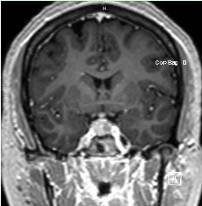
Types of Pituitary Adenomas
Pituitary adenomas are classified by their size and whether or not they secrete hormones.
Endocrine-Active Pituitary Tumors
About 50 percent of adenomas produce excessive amounts of one or more particular hormones. These endocrine-active tumors are also known as secreting or functioning tumors. Excessive hormone secretion may cause:
-
Cushing’s disease: Due to excessive corticosteroids in the body, Cushing’s syndrome can cause a number of symptoms, including:
-
Upper body obesity
-
Round face
-
Increased fat around necK or a fatty hump between the shoulders
-
Thinning arms and legs
-
Fragile and thin skin
-
Stretch marks on abdomen, thighs, buttocks, arms, and breasts
-
Bone and muscle weakness
-
Severe fatigue
-
High blood pressure
-
High blood sugar
-
Irritability and anxiety
-
Excess facial and body hair growth in women
-
Irregular or stopped menstrual cycles in women
-
Reduced sex drive and fertility in men
-

-
Acromegaly: Excessive growth results in the enlargement of the extremities, face and soft tissues. Acromegaly may be associated with hypertension, diabetes mellitus and cardiovascular disease. Patients with acromegaly have decreased life expectancy.
-
Galactorrhea: This condition is characterized by abnormal milk production from the mammary glands.
-
Reproductive problems, such as infertility
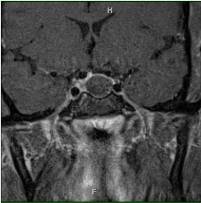
Prolactinoma is a type of pituitary tumor that overproduces prolactin. The prolactin hormone stimulates milk production from the breasts. Prolactin-secreting pituitary adenomas are the most common type of pituitary tumor, accounting for approximately 30 percent of all pituitary tumors.
Endocrine-Inactive Pituitary Tumors
Endocrine-inactive pituitary tumors do not produce extra hormones. They are also called nonfunctioning or nonsecreting pituitary tumors.
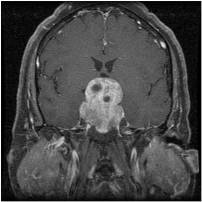
Microadenoma and Macroadenoma
Microadenomas are pituitary adenomas that measure less than 10 mm in diameter (about three quarters of an inch). A pituitary adenoma greater than or equal to 10 mm in diameter is called a macroadenoma.
Pituitary Adenoma Diagnosis
Your physician may use blood tests, urine tests and imaging to diagnose a pituitary adenoma. Blood and urine tests can detect abnormal levels of hormones such as plasma prolactin (PRL), growth hormone (GH), insulin-like growth factor-1 (IGF-1), free thyroxine, cortisol, and testosterone. Abnormal amounts of certain hormones may indicate a specific pituitary-related syndrome.
Your physician may also use enhanced, high-resolution MRI technology to identify unique characteristics of a pituitary adenoma.
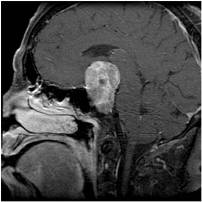
Pituitary Adenoma Treatment
The most effective treatments for adenomas are coordinated by a multidisciplinary team that includes a neurosurgeon, otolaryngologist and/or an endocrinologist (hormone disorder specialist). Treatment may include a combination of observation, medication (including hormone therapy), radiation therapy and surgery.
Observation
Observation involves seeing a neurosurgeon or endocrinologist who can prescribe a regular schedule of imaging tests to check the status of the tumor. If the pituitary tumor grows or if symptoms worsen, you may need to pursue further treatment.
Medication
Medication (drug therapy) can be very effective in treating some hormone-producing pituitary tumors. It may be used to:
-
Stop a tumor from producing excess hormones.
-
Shrink the tumor to stop it from pressing on the pituitary gland or other parts of the nervous system.
-
Treat a pituitary tumor or control hormones after surgery or radiation therapy.
-
Substitute missing hormones if a pituitary tumor has decreased the body’s ability to produce the necessary hormones or if hormone production is too low after surgery (also known as hormone replacement therapy).
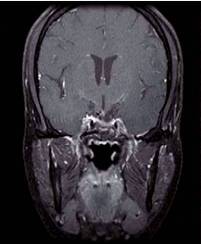
Radiation Therapy
Radiation therapy for pituitary tumors includes external beam radiation therapy and stereotactic radiosurgery. It can take several months for these treatments to improve symptoms and conditions related to pituitary adenoma.
Radiation treatment might be appropriate for pituitary adenomas that:
-
Are located in areas of the brain where surgery is too risky.
-
Cannot be completely removed during surgery.
-
Grow quickly.
-
Do no shrink with medication.
-
Recur after surgery.
Sometimes radiation therapy can cause the pituitary gland to stop working, even years after treatment. In that case, individuals may need to take hormone supplements.

Surgery
Surgery to remove a pituitary adenoma may rarely require a craniotomy, but more typically involves a minimally invasive procedure called an endonasal endoscopic surgery where the surgeon removes the tumor through the nose. It is important to work with a knowledgeable team with a lot of experience in pituitary tumor surgery.





